
MAY CONTAIN NUTS

Search Shorpy
SHORPY ART

Framed or unframed, desk size to sofa size, printed by us in Arizona and Alabama since 2007. Explore now.
Join and Share
Ad-Free Shorpy
Shorpy is funded by you. Patreon contributors get an ad-free experience.
Learn more.

Recent comments
- The Last Bickford's
- Re: And literally just around the corner
- Straight from Central Casting
- And literally just around the corner
- How did Vachon do it?
- Clean on the outside
- You write Bickfords, I write Bickford's
- Clean Outside In
- Don't interrupt the photographer
- Immortalized for Posterior
- Still standing on Fayette Street
- Takin' Care of Business
- Balt Noir
- Joke
- I Wish
- Texas Landscapes
- Unfun
- Not just one
- Dress Code
- Status
- Brakeman?
- A couple of Stormy Kromers
- ¿Por qué dos locos?
- Oklahoma
- Dos Locos
- Double Header
- Wagon Top!
- It really is that flat
- Time Travel
- Now I know
Member Photos
The Shorpy
Printporium
Printporium
Search Shorpy
Search results -- 30 results per page
- High Roller: 1912
- ... capital.
"The Lion of Idaho" was the father of Alice Roosevelt Longworth's daughter, a fact long suspected but only recently ... unsuccessful candidate for the Republican nomination for President in 1936.
Born in Eureka, Calif., Mrs. Borah grew up in Moscow, ... Posted by Dave - 08/28/2012 - 10:15pm -
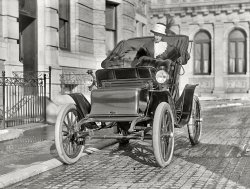
- Isham Jones Orchestra: 1922
- ... worship at Foundry or became his friends in Congress were President Franklin D. Roosevelt and Prime Minister Winston Churchill, who attended a special service ... Posted by Dave - 08/01/2012 - 5:37pm -
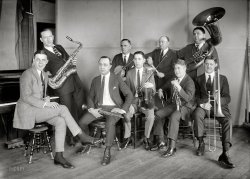
- Harvard Gold Coast: 1911
- ... in April 11, 1927, Time Magazine , about how Harvard President Lowell wanted each class to share the same dormitories, regardless of ... and appointed to be exactly as it was when Franklin Delano Roosevelt (Class of 1904) was living there. I stayed in a Claverly Hall suite ... Posted by Dave - 04/05/2023 - 1:03pm -
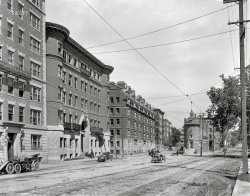
- Atwater Kent: 1927
- ... year. The dealers were the guests of William E. O'Connor, president of the Southern Auto Supply Co. , at the banquet.
The dealers ... of State Governors during the administration of Theodore Roosevelt, who then appointed him secretary of the National Conservation ... Posted by Dave - 05/02/2016 - 11:18am -
![Atwater Kent: 1927 Washington, D.C., circa 1927. "Thomas R. Shipp group, Hamilton Hotel. Atwater Kent standing by radio." National Photo Co. safety negative. View full size.
Fuller is rightthat Kent walked away with big bucks, not a failure. One of the big reasons that he closed the company down when he did was the threat of unionization by his workers. he said that if they persisted in attempts to unionize, he would close the company. They did, and he did.
The factory was eventually taken over by Philco and produced enormous number of radio before, during, and after, WW2. Sometime in the late 50s/early 60s, Philco sold at least part of the property to the Government, and it became a Veterans Administration Data Processing Center, full of equipment that, by today's standard, was as about as advanced the radios made by Atwater Kent!
Model 33 in a Pooley CabinetThe set is an Atwater Kent Model 33 in a Pooley 1700-R-2 cabinet. Pooley had a deal with AK -- customers could order from their line of radio cabinets, and then pick from any number of available AK sets to go in it. The cabinets cost anywhere from $190 to $240, and the radios $145 to 390. That was a pretty hefty sum in 1927 -- even more so when you consider that the delivered radio-cabinet set came without tubes or a battery, which the buyer had to purchase separately.
Mr Kent appears to be showing off the latest model -- the 33 was manufactured in 1927, and the Pooley 1700 started production in 1926. The radio isn't a Model 30 (manufactured in 1926) -- the knobs on the 30 were closer together.
Pinpointing the dateThis is one of those photos where, with a little detective work, one can easily figure out what month of the year it was taken. The cover of the Cosmopolitan magazine that woman is holding is clearly visible.
[February 1927. - Dave]
Attentive StareAlthough obviously a posed picture, interesting how everyone is "watching" the radio set. Replace the speaker grille with a small TV screen and this could be 1949 (at least, if you look more at the mens' outfits).
Looking at the radioYou see, if you look at the radio, your ears just happen to be pointing in the best possible direction for you to hear best as well. One of nature's little tricks.
Attention pleaseIf you don't look at the radio, you can't hear it.
And the lady on the left has taken one of the drapery ruffles and fashioned a hat.
What are they looking at?Why is everyone looking at the radio? They have a good 20 years to wait until a screen pops out of that thing.
Radio daysThe fact that they're all looking at the radio is hilarious, and reminds me of a line from Woody Allen's Radio Days. "He's a ventriloquist... on the radio! How do you know he's not moving his mouth?" I paraphrase, but you get the idea. The one visible female face has a highly amusing expression on it. Most everyone else appears somber and she's sort of simpering, seemingly unable to get into character.
Interesting PieceThe radio cabinet could double as a writing desk. I wonder if the area below the desk is a functional drawer or storage space of some sort or does it have any part of the electronics.
Atwater KentAtwater Kent provided radios for various manufacturers to include in their own cabinetry. This one looks like a model 30, produced in 1926 and notable for single-knob tuning:
http://www.atwaterkentradio.com/ak30.htm
Atwater Kent himself!Funny that I always assumed "Atwater-Kent" was a combination of two names, like "Nash-Kelvinator" or "White-Westinghouse." Unless, of course, the caption actually means "standing by Atwater Kent radio."
Note the Cosmo girl to his left--this being the days when Cosmopolitan was like a mixture of Redbook and Literary Digest.
RearrangedLooks like they might've dragged some furniture around to better compose the shot. A smart hunter would've swept that plant around to cover his tracks.
Play by PlaySteeeRIKE THREEE!! and he's OUT!
Thomas Roerty Shipp
Washington Post, Aug 20, 1926
Greater Radio Sales Predicted Next Year
Dealers, Closing Meeting With Banquet,
Base Forecast on Broadcasters' Rivalry
A larger business in radio sets for next year was predicted at the annual meeting of the radio dealers of Washington, Maryland, and Virginia that closed with a banquet at the Lee house last night. The high quality of radio programs being broadcast together with rivalry between the broadcasting stations to procure the best talent was the basis for the prediction.
A representative of the Atwater Kent factory reported that the Philadelphia plant had already received a sufficient number of orders to warrant the manufacture of more than 600,000 radio receivers this year as compared with a 400,000 order on hand at this time last year. The dealers were the guests of William E. O'Connor, president of the Southern Auto Supply Co., at the banquet.
The dealers were welcomed by M.A. Leese, local radio dealer and president of the Washington Chamber of Commerce, followed by greetings from F.C. Ferber, vice president and secretary of the Southern Auto Supply Co. Others who spoke were C.W. Geisner and P.A. Ware of the Atwater Kent Co.; T. Cronyn, S.D. Goodall, G.O. Hamilton and H.W. Jarrett, all of New York and Thomas R. Shipp, of this city.
Washington Post, Sep 12, 1927
"Better Broadcasting"
Talk By Bullard Today
Having explained to listeners, station owners, manufacturers and others the part they must play in the national program for better broadcasting, two members of the Federal Radio Commission today will being to enlist the cooperation of radio dealers in the movement. To this end, Chairman W.H.G. Bullard will address the annual Atwater Kent dealers meeting at the Hotel Hamilton, taking for his topic, "How Radio Dealers May Aid the Radio Commission." At the same time Commissioner H.A. Bellows will address the Atwater Kent dealers in Philadelphia.
To day's program in Washington will open with a housewarming this morning at the Southern Wholesalers Inc., distributors, followed at 12 o'clock with a luncheon at the Hamilton. Then will come an afternoon business session, concluding with a banquet at 6 o'clock followed by vaudeville.
Washington Post, Feb 11, 1952
Thomas Shipp Dead in Miami
At Age of 76
Thomas Roerty Shipp, 76, veteran public relations man and one of the founders of the National Press Club, died yesterday in Miami, Fla., where he and his wife had been spending the winter.
Mr. Shipp came to Washington in 1908 to organize the first conference of State Governors during the administration of Theodore Roosevelt, who then appointed him secretary of the National Conservation Commission. He was public relations advisor for such corporations as General Motors, Standard Oil Co. of New York, the Pullman Co., Swift & Co., International Harvester and many others.
Mr. Shipp organized the first national and international publicity campaigns for the American Red Cross in World War I and headed the national publicity drives of the Y.M.C.A. and United War Work Campaign. A native of Morristown, Ind., Mr. Shipp was nominated by the Republicans for Congress but was narrowly defeated in the election. He then became the Indiana member of the Republican National Congressional Committee and directed the publicity campaign for the party in 1914.
In 1914 he organized the Thomas R. Shipp publicity company, with offices in the Albee Building. He lived at 3733 Oliver st. nw.
Mr. Shipp was a mason, a member of the Chevy Chase Club, Columbia Country Club, National Press Club, Artists and Writers of New York City and a member of the Indiana Bar. Funeral services will be held Tuesday in Indianapolis, with interment there.
AK ClosingKent never "failed" in the radio business or in any other business. In 1936, he was a solvent multimillionaire. He had his son, A. Atwater Kent Jr., sell the factory buildings and other company assets, which were all his personal, debt-free, property. He retired to California, where he became famous for his flamboyant parties. He died a wealthy and reportedly happy man.
Atwater Kents were the bestAtwater Kents were the best set you could buy back then. If you ever compare a RCA, GE, or Philco radio from the 20's-30's to an Atwater Kent set of the same era, the AK radio wins by a landslide. Unfortunately the sets were too expensive for them to survive the Depression.
14th StreetI think the street outside the window is 14th, with the cars parked in the alley across from the Hamilton that connects 14th and Vermont (in between the current Continental and and Tower buildings).
LusciousI wish I could see all those rich fabrics in color. Velvets, brocades, satins...mmmm!! They're probably in lovely jewel tones.
(I also want all the women's shoes, especially the adorable mary janes on the left.)
Way Back My grandparents & I used to listen to the radio in the evenings. Amos & Andy, Walter Winchell. This brings back good memories.
AK CabinetThe Pooley cabinet is a Model 32.
Mr. Kent sells his company.Sounds like he "went John Galt."
(The Gallery, D.C., Natl Photo)](https://www.shorpy.com/files/images/31034u.thumbnail.jpg)
- Model Citizens: 1924
- ... served as an Assistant Secretary of the Interior under President Theodore Roosevelt. He attended Roosevelt High School in Los Angeles. He became a lawyer ... Posted by Dave - 09/03/2012 - 10:42am -
![Model Citizens: 1924 August 12, 1924. "International Boys Leagues. Thomas W. Miles and Simon Zebrock of Los Angeles at White House." View full size. National Photo Co.
Tom and SimonAccording to my research, Thomas W. Miles was born in West Virginia in 1907, and died in Washington, DC, on April 9, 1997. Simon Zebrock (official records indicate spelled Zebrack) was born in Missouri in 1908, and was killed in WWII in 1943.
The UndergraduateAmazing how much the fellow on the right looks like a young Dustin Hoffman!
Tom and SimonThis is Joe Manning again. Further research seems to indicate that the Thomas W. Miles who died in Washington, DC is not the same as the one in the photo. In addition, I just discovered that the Thomas Miles I originally tracked down in the census in Los Angeles, born in 1907, turns out to be white, and the Thomas in the photo appears to be African-American. So it looks like I got this one wrong. I'll work on this some more.
Tom's ShoesI like Thomas's shoes very much, wonder what they are called.
Thomas W. MylesAccording to my research (including numerous articles in the Los Angeles Times digital archives), Thomas William Myles Jr. (not Miles) was born in 1906. His father served as an Assistant Secretary of the Interior under President Theodore Roosevelt. He attended Roosevelt High School in Los Angeles. He became a lawyer and married Dorothy (maiden name unknown) in 1929. When he was 18, he traveled to Paris for a convention of the International Boys League and was elected the organization’s president. He was also president of the California chapter of the junior branch of the NAACP. He was an active advocate for civil rights for African-Americans, and ran for the California State Senate in 1938. He died in Los Angeles on May 2, 1985. I could not locate an obituary, and do not know if he had any children.
TomHe could be wearing spats over regular shoes---I think that was still fairly common in the '20s. Not so easy to find now, but you sometimes can find them through theatrical costume suppliers.
I really like the shine on the shoes!Looks like those fellows knew how to do a good spitshine. Did they have patent leather in '26?
[More than they do today. - Dave]
FatherI was wondering if that was a picture of my Father, Thomas Myles born in 1906 attended Roosevelt High and was a lawer
(The Gallery, D.C., Natl Photo)](https://www.shorpy.com/files/images/26019u.thumbnail.jpg)
- Crafty Kids: 1930
- Circa 1930. "No caption (President Hoover with boys and girls at White House)." Who can help us fill in ... about his economic policies, Herbert Hoover was the first president since TR to invite persons of color to the White House socially. And unlike Roosevelt who did it only once and wilted under ferocious criticism from ... Posted by Dave - 03/21/2015 - 1:14pm -
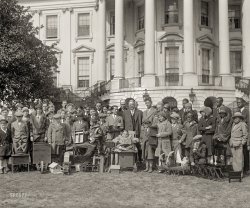
- Young FDR: 1911
- Franklin Roosevelt in a portrait dated February 3, 1911, a few days after his 29th ... a lot of use now.
A way with words His years as president will always be debated, but his speeches were moving, the only thing ... (and for what it's worth) that at the time of this photo, Roosevelt walked. He contracted polio in 1921, and spent the rest of his life ... Posted by Dave - 09/07/2011 - 10:39pm -
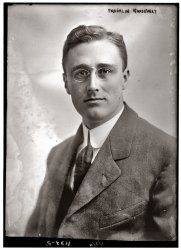
- 1942: Family No. 1319
- ... south weren't rounded up and put in concentration camps. Roosevelt gave in to racists in California. But perhaps Earl Warren learned ...
No excuses. It was racism. I would point out that President Roosevelt admitted to his wife, Eleanor that the so-called evacuation ... Posted by Dave - 03/10/2021 - 11:30am -
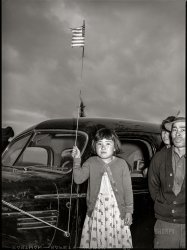
- Circus Baby: 1926
- ... her putative father, Senator Borah ... Nice to see Alice Roosevelt Longworth smiling!
Circus Babe Interesting. I thought she ... Longworth was a very colorful character. Her father, President Theodore Roosevelt, once said, "I can run the country or I can ... Posted by Dave - 09/11/2011 - 11:53am -
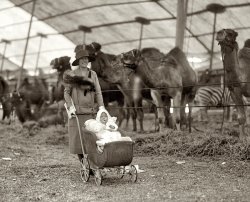
- Whistle Stop: 1936
- August 1936. "Tour of drought area. President Roosevelt speaking from train at Bismarck, North Dakota." Medium format nitrate ... is gripping the arm of what I believe to be his son James. Roosevelt was completely paralyzed below the waist and had to use other people ... Posted by Dave - 07/30/2012 - 10:03pm -
![Whistle Stop: 1936 August 1936. "Tour of drought area. President Roosevelt speaking from train at Bismarck, North Dakota." Medium format nitrate negative by Arthur Rothstein for the Resettlement Administration. View full size.
Family supportAlthough James was reported to be the one with his father, this certainly looks more like Franklin, Jr., who had just celebrated his 22nd birthday 10 days before. Not visible in the photo but also on the rear platform of the train was FDR's daughter, Anna. At right is ND Governor Walter Welford. Film footage of the event is here.
Lean on meFDR is gripping the arm of what I believe to be his son James. Roosevelt was completely paralyzed below the waist and had to use other people to help create the illusion of his being able to stand and walk. Great care was made to foster this illusion and the press generally went along with it. To this day there are no more than a handful of photographs of FDR in a wheelchair or that show his leg braces.
This is one reason so many photos of him were taken on the back of trains, where he could grip the railing, or in open cars where he didn't need to be seen moving under his own power. In fact whenever he was expected to deliver an outdoor speech other than from a rail car the Secret Service would build wooden ramps on the speaking platform so his car could drive right up onto the stage behind all of the dignitaries. who served to mask FDR from the crowds and cameras. Then they would pick him up from his car and stand him up with his leg braces and more or less carry him, one man on each side, to the speaking podium. Roosevelt would swing his arms and it appeared to all but those right next to him that he was walking.
"1936, You call this a drought?wait for the next two years."
Indiscreet then but history nowA long gone friend of my Father, Dr.Howard Rosenthall, somehow managed to film FDR in his actual physical state being helped from his limo during a visit to Vassar College. At the time this was NOT the correct thing to do; but, I am told, his film ended up at the Roosevelt Library were it is kept as a historical item.
Google HimIt's plainly Franklin Jr. and not James.
[Indeed. Three examples. - tterrace]
(The Gallery, Arthur Rothstein, Dust Bowl, Politics, Railroads)](https://www.shorpy.com/files/images/SHORPY_8b28235a.thumbnail.jpg)
- Naval Maneuvers: 1901
- ... wearing his hair in the manner that matches most photos of President Roosevelt at the time.
The Superintendent's daughter The Academy's ... Posted by Dave - 07/29/2012 - 1:28pm -
![Naval Maneuvers: 1901 Annapolis, Maryland, circa 1901. "Cadets at residence of superintendent, U.S. Naval Academy." 8x10 glass negative, Detroit Publishing Co. View full size.
Many years later... in a land over the rainbow, the sister of the young lady with the hat died in a tragic accident when a house fell out of the sky and struck her. The Munchkins were thrilled!
Exquisite shotAnd a very explicit look.
"How can I tell her that I love her?"
No lack of confidence here.Every one of these young people has the look and body language of supreme confidence. Ok, except for Mr. Daydreamer behind the hat lady. He's somehow fascinated and mesmerized by the millinery I suppose.
WhatisitOne of the young men is holding something that I can't even guess what it is.
[Perhaps one of the dainty folding fans favored by sailors of the era. - Dave]
The GazeI don't see love in his eyes. He's probably thinking "Why on earth does she keep a dead pigeon on her head?"
This fellow's nameMidshipman Smitten.
Love triangleObviously, the young man in the closeup below is smitten with the girl with the puffy hat in front of him. She, in turn is eyeing one of the likely lads to her right.
Hat in handMidshipman Smitten obviously has a thing for the cute young lady directly in front of him, and she is holding his cap!
She stole his hatto get his attention, so they are mutually smitten.
GaslightWould love to see that gas chandelier in the foyer ablaze at night with a circle of fishtail flames flickering through the globes.
Ahead of his timeI'm wondering about the melatonin-advantaged (Asian? Hispanic?) fellow in the middle of the picture. I wonder what sort of career he could have had in the Navy.
Or perhaps he was an exchange student from Japan? This was about the time they were working hard to create a "modern" Navy.
[He's probably Filipino, his countrymen numbering among the "newly acquired peoples" granted admission to U.S. military academies in 1901 following the defeat of Spain in the Spanish American War. - Dave]
"Academy" - the miniseriesFollowing the trials and loves of The Class of '05 - Purvis, son of a Congressman, ambitious and dim and in love with Fanny, the Superintendent's daughter; Jake, the brilliant but diffident cadet unaware of Fanny's longing looks but well aware that her father, "The Admiral" is prepared to stop at nothing to have him drummed out of the Academy; Violet, Fanny's beautiful "City" cousin, whose dazzling smile turns the heads of most of the men on campus; Manolo, the first Filipino cadet in the history of the Academy whose dark, exotic looks have attracted the eye of Walter, Fanny's older brother, whose aspirations lie not in the Navy but on Broadway - Manolo, alas, has already fallen for Bert, the Academy's football star ...
I'll be waitingFor "Academy" Season 1, Episode 2. Written by Mudhooks, produced by Dave, directed by Shorpy.
Hilarious Comments on this Pic!I think there is a possibility that the young man staring across the porch and the girl, are brother and sister. They seem to favor.
Edvado, that is exactly what I was thinking. Miss Elvira Gulch.
Poor girlMisses #1 and 2 overwhelm Miss #3 who is mostly hidden to the right. I bet she complained of not being given enough "face time" in the photo.
CNOErnest King, CNO during WWII, was Class of '01. Any chance he's in the picture?
I feel a song comin' onThe trio of theatrical looking lads on the extreme left seem posed to begin singing a rousing rendition of a show-stopping musical number, perhaps something like "Anchors Aweigh" or some other toe-tapping, patriotic naval song. Can't you just see them stepping off the porch and doing their drill down the sidewalk?
Season 2 of "Academy"Heart-broken after the disappearance of Jake during a daring rescue of Bill the Goat, the college mascot, from the crow's-nest of the USS Chesapeake, Fanny reveals to Violet a terrible family secret.
Sixteen years early, "The Admiral", while on a drunken and debauched week in New Orleans, fell madly in love with one of "les filles" at Madame Fricassee's "Maison de Mauvais Parfum". Alas, "Collette", the object of his desire, was in fact Mabel, the laudanum-addicted, wayward wife of none other than "The Admiral's" own brother - and mother of Violet. Nine months later, "Collette" gave birth to a son and promptly died of Yellow Fever. The ever-resourceful Madame Fricassee employed the services of even more resourceful Sam Huckabee, private detective, to track town "The Admiral".
A financial arrangement was reached and Oswald, the product of the brief union of "The Admiral" and "Collette", was raised by Madame Fricassee and "les filles". Eventually, "The Admiral" agreed to have him enrolled at the Academy, as long as Oswald was never told of his actual parentage.
Fanny had come across "The Admiral's" stash of letters from Madame Fricassee and reveals all to Violet.
Violet, in turn, has her own secret ...
Feigning indifference to one another Oswald and Violet have secretly eloped and Violet is with child.
Another possibilityIs that the Asian-looking midshipman is Hiroaki Tamura, graduated 1900. Last of some 15 Japanese cadets who attended between 1869 and 1900.
Another Japanese graduated in 1993.
If I may ask an obvious questionWas parting one's hair in the middle mandatory in those days? The one guy in the picture whose part is slightly off-center is wearing his hair in the manner that matches most photos of President Roosevelt at the time.
The Superintendent's daughterThe Academy's superintendent from 1900 to 1902 was Commander Richard Wainwright. He and his wife Evelyn had one daughter, Louisa. She was chosen to christen the submarine USS Shark (SS-8) in 1901. The Boston Globe reported on October 29, 1902 that Miss Wainwright wed Lt. Walter Stevens Turpin (in the drawing room of "the superintendent's new residence"). He was the son of a former Maryland state senator. Do not look for him in this photo; he graduated from the academy in 1894, and was stationed at the Crescent Shipyards in Elizabethport NJ in 1901 and the USS Indiana in 1902.
Dating the MidshipmenI’m thinking this photo was taken in 1894-1896. Big balloon sleeves on women's clothing started to appear around 1894 and by 1897 were gone. Also the hats they’re wearing are more typical of the mid 1890s. The LOC gives the date range of the U.S. Naval Academy photos as between 1890 and 1901.
[This particular image is listed in Detroit Publishing's 1901 catalog. - Dave]
Update on cadetsBIG update! The one in the center, seated between hat lady and the woman you can't see much of is future Vice Admiral Joel Roberts Poinsett Pringle USNA 1892. The cute boy who is entranced with the girl is the future CPT William Lord Littlefield, Class of 1896. Behind Pringle is Motohiko Takasaki, class of 1895, Empire of Japan, who designed the class ring for that year. On the right side of the picture are L-R, Roscoe Spear and Charles Webster, class of 1894.
DonY commented that the fashions on the women suggested the date to be the mid-1890s, rather than 1901. He was correct! The only time men from all of these classes would have been there, still as Naval Cadets, was in the Summer of 1894. Pringle was back from the two years "service afloat" that was required after graduation, and would be appointed an Ensign, in July. Spear and Webster would have been preparing to start their service afloat. Takasaki and Littlefield still had to finish their studies.
The dean at USNA, that year, was CPT (later Commodore) Robert Lees Phythian. He had two daughters, Bonnie, born 1871, and Cordelia, born 1874. My guess is that the object of Cadet Littlefield's affection was Cordelia. He didn't marry her, though. In fact, she married then LT Pringle, in 1899, and their daughter and her children also carried on the USNA/Navy tradition!
Here's a Lucky Bag photo of the class of 1895, in which you will see Motohiko Takasaki and a few others found in this picture, but which I can't identify. Click to enlarge.
Included in the group photo are Worth Bagley, the only line officer killed in the Spanish-American war, in the far upper left corner, and the very tall you man on the right side, in the very back, who was John Robert Monaghan. Monaghan was killed in 1899, in the second Samoan civil war.
There's a picture of our smitten Cadet Littlefield here.
(The Gallery, DPC)](https://www.shorpy.com/files/images/4a15065a.thumbnail.jpg)
- Lush Life: 1937
- ... to perform a vital mission: to deliver an invitation to President Roosevelt to attend the Mountain State Forest Festival at Elkins, West ... Posted by Dave - 07/27/2012 - 12:23pm -
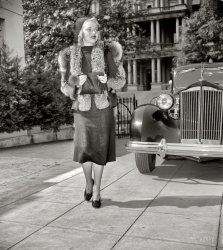
- Visibility: Spotty
- ... ever visit Sagamore Hill, they have a piece of Theodore Roosevelt's youngest son Quentin's plane from the Great War -- the one he was ... are SHOOTING AT YOU.
TR, of course, was the first president to fly. He used a plane, but he didn't need one.
The Wright Stuff ... Posted by Dave - 07/08/2014 - 1:12pm -
![Visibility: Spotty Washington, D.C., circa 1911. "Flights and test of Rex Smith biplane flown by Antony Jannus. The plane with Rufus R. Bermann, wireless operator, and Fred Aubert." Whose somewhat pixilated appearance can be attributed to mold on the emulsion. Harris & Ewing Collection glass negative. View full size.
Mars or bustNo no it's not emulsion degradation, it's a clever overlay technique Harris & Ewing did to portray the lads flying into the Milky Way.
Rufus looks like he had a sleepless night.
Wheee!The spots give them a cartoonish, inebriated look. Don't drink and fly, kids!
ETA: This is what came to mind. Eventually.
Forever blowing bubblesIt looks like a segment from the Lawrence Welk Show.
Not QuiteAs much as I like the ‘’ bubble machine’’ effect: I’ll take Senorita Lenore Riviero
in the previous post anytime! And, I mean how! (whoopee)
The second requisite to braveryButtocks of steel.
Chicken LittleSwitzarch, you were spot-on with your post, they were a lot more brave than I am, I'll tell you that much!
Their faces say:We who are about to die salute you.
Early AviationIt appears that every passenger has that "this is not going to end well" look.
Wood and FabricThat's all they were for the most part. If you ever visit Sagamore Hill, they have a piece of Theodore Roosevelt's youngest son Quentin's plane from the Great War -- the one he was shot flying -- and it's a wooden stick! Not only is it almost inconceivable to imaging going up in such a contraption, but try imagining going up in one only slightly more advanced while people are SHOOTING AT YOU.
TR, of course, was the first president to fly. He used a plane, but he didn't need one.
The Wright StuffThis photo looks like the first documented evidence of manned space flight.
Flying attireHow many co-pilots would consider pince-nez and homburg proper flying gear?
No restraintDid they really wear no seat belts or restraint of any kind? I can't see any.
S.O.S. The title "wireless operator" is interesting. I wonder if they were carrying some sort of apparatus. I notice his right hand is over something. Could be just a seat brace or perhaps some sort of Morse code key? Also couldn't help noticing that I can't see anything that looks like a seat belt.
ApprehensionOne unifying feature of all early aviation pictures. It's hard to realize the bravery it took to 'be among the first' to try this new form of transportation. We owe them a lot.
Are you sure that's mold?Near-sighted hunters mistaking Rufus and Fred for a Canada goose.
Not so happyTony doesn't seem quite as excited about taking this sourpuss aloft as he did with the pretty socialite.
[Tony's not here. - Dave]
Doi . . . . It helps to read captions, don't it? Anyway, neither of them looks too elated.
Re: S.O.S.Another Shorpy delight that spans the years: Zcarstvnz in 2018 clears up a mystery from 2011. In the comment by Fitz (S.O.S.) over seven years ago, he asks, with reference to Rufus R. Bermann on the left, “I notice his right hand is over something. Could be just a seat brace or perhaps some sort of Morse code key?” In the newspaper piece from 1911 provided last night, we find the answer to that question: “The sending key was set on the side of the passenger’s seat on the right of the operator.” I note that Fitz’s last comment was over six years ago, but I hope he’s still around to read this answer to his question from 2011.
... .--. --- - - . -.. From the Evening Star of April 9, 1911, Part I, Page 7
-----------------------------------------------------------------
(The Gallery, Aviation, D.C., Harris + Ewing)](https://www.shorpy.com/files/images/00119a2.thumbnail.jpg)
- Meet the Smoots: 1910
- ... This is very controversial. Does anyone know what Vice President Bush called this in 1980? Anyone? Something-d-o-o economics. "Voodoo" ... ecomonically illiterate at the time Don't forget that Roosevelt and the Democrats also supported anti-trade legislation. Roosevelt ... Posted by Dave - 08/09/2012 - 12:04pm -
![Meet the Smoots: 1910 Washington, D.C., circa 1910. "Senator Reed Smoot, group." The longtime Utah lawmaker gave his name to the Smoot-Hawley Tariff. View full size.
OrOr Hoot-Smawley, if you listen to Michelle Bachmann.
A Wild GuessIt looks to me as if the good senator might have given his name to more than the Smoot-Hawley Tariff.
Seemed like a dood idea at the time"The Smoot-Hawley Tariff Act imposed an effective tax rate of 60% on more than 3,200 products and materials imported into the United States, quadrupling previous tariff rates." (Wikipedia).
Which, at the time, was like running the engine of international trade straight into a brick wall at full speed. Thank goodness we have better leaders now, who know what they're doing!
Ahem, ahem.
What a schmuck The Republicans totally deserved the string of absolute electoral defeat that followed Hoover and that ridiculous tariff. It was well known that tariffs only helped industry and devastated farmers (which was fine when the nation was just developing its industrial base, but became wholly inappropriate around the time Dewey took Manila), one of the most dearly affected groups of the Depression (especially considering the effects of the Dust Bowl).
And now for the ad hominem -- the good senator doesn't seem able to put his collar and tie together properly. He should ask for a lesson from his sons. This is not to mention the somewhat befuddled look on his face.
[The Senator is wearing an Edwardian-style standing collar -- it's supposed to look like that. The boys are wearing fold collars. - Dave]
Movies on the brainBut for the fact it's not in Technicolor, this could be a scene from "Life With Father."
Smite, Smoot!(SMOOT PLANS TARIFF BAN ON IMPROPER BOOKS - News Item)
Senator Smoot (Republican, Ut.)
Is planning a ban on smut.
Oh rooti-ti-toot for Smoot of Ut.
And his reverend occiput.
Smite, Smoot, smite for Ut.,
Grit your molars and do your dut.,
Gird up your l__ns,
Smite h_p and th_gh,
We’ll all be Kansas
By and by.
Smite, Smoot, for the Watch and Ward,
For Hiram Johnson and Henry Ford,
For Bishop Cannon and John D., Junior,
For ex-Gov. Pinchot of Pennsylvunia,
For John S. Sumner and Elder Hays
And possibly Edward L. Bernays,
For Orville Poland and Ella Boole,
For Mother Machree and the Shelton pool.
When smut’s to be smitten
Smoot will smite
For G-d, for country,
And Fahrenheit.
Senator Smoot is an institute
Not to be bribed with pelf;
He guards our homes from erotic tomes
By reading them all himself.
Smite, Smoot, smite for Ut.,
They’re smuggling smut from Balt. to Butte!
Strongest and sternest
Of your s_x
Scatter the scoundrels
From Can. to Mex!
Smite, Smoot, for Smedley Butler,
For any good man by the name of Cutler,
Smite for the W.C.T.U.,
For Rockne’s team and for Leader’s crew,
For Florence Coolidge and Admiral Byrd,
For Billy Sunday and John D., Third,
For Grantland Rice and for Albie Booth,
For the Woman’s Auxiliary of Duluth,
Smite, Smoot,
Be rugged and rough,
Smut if smitten
Is front-page stuff.
-- Ogden Nash
Either...his mustache is growing right out of his nose, or he just inhaled a couple chipmunks!
Anyone? Anyone?In 1930, the Republican-controlled House of Representatives, in an effort to alleviate the effects of the... Anyone? Anyone?... the Great Depression, passed the... Anyone? Anyone? The tariff bill? The Hawley-Smoot Tariff Act? Which, anyone? Raised or lowered?... raised tariffs, in an effort to collect more revenue for the federal government. Did it work? Anyone? Anyone know the effects? It did not work, and the United States sank deeper into the Great Depression. Today we have a similar debate over this. Anyone know what this is? Class? Anyone? Anyone? Anyone seen this before? The Laffer Curve. Anyone know what this says? It says that at this point on the revenue curve, you will get exactly the same amount of revenue as at this point. This is very controversial. Does anyone know what Vice President Bush called this in 1980? Anyone? Something-d-o-o economics. "Voodoo" economics.
The Eyes Have ItThe eyes each tell the story inside.
I nose this.All but one got Daddy's.
Last GaspCan't breathe...collar too tight...cutting off blood supply to brain...
The Leftist SmootsMost of the Smoot family seems to be left-leaning. I mean their poses, not their politics, and their left, not ours.
BeautifulWow, the detail work on Mom's dress is absolutely gorgeous! Where is that time machine? I love how the everyone is looking at the camera except the youngest boy, who got distracted by something else. How typical.
Great-Grandma, is that you?Mrs. Smoot looks just like my paternal grandmother. She would have been about the same age as the youngest boy with the funny bangs when this picture was taken.
Both parites were ecomonically illiterate at the timeDon't forget that Roosevelt and the Democrats also supported anti-trade legislation. Roosevelt thought the cause of the depression was too much competition, so actually jailed retailers who gave discounts to their customers.
[And then, ahem, there's literal illiteracy. - Dave]
Not exactly the Cleavers.........but a handsome group nonetheless.
RedskinsAnd here the only Smoot in DC I'd ever heard of was Fred, cornerback of the Redskins....
BurialNice entry on Find-a-Grave for Sen. Smoot.
InterestingThe mother's corset must be an old one. Her dress is not quite in style either (see her daughters' Gibson Girl saggy-chest look).
The SmootsPictured with Reed Smoot are his wife Alpha M. Eldredge and their children (in order of birth) Harold Reed, Chloe, Harlow Eldredge, Annie K., Zella Esther and Ernest Winder.
(The Gallery, D.C., Harris + Ewing, Portraits)](https://www.shorpy.com/files/images/16707a.thumbnail.jpg)
- Memorial Bridge: 1931
- ... to Georgetown, north of Memorial Bridge. Until the Roosevelt Bridge was built upstream, Memorial would be opened for river ... Bridge Viewed by Officials,
With Grant as Guide
President Hoover yesterday inspected the nearly completed memorial bridge which ... Posted by Dave - 11/18/2019 - 4:08pm -
![Memorial Bridge: 1931 Washington, D.C., circa 1931. "Construction of Arlington Memorial Bridge over Potomac River." Acetate negative by Theodor Horydczak. View full size.
The Drawbridge of DignitariesAt the time of the Memorial Bridge's design, planners anticipated a dock for berthing the ocean-going ships of foreign dignitaries visiting Washington, D.C. Such ships would ply their way up the Potomac River and through the drawbridge span, shown in detail here. Immediately upstream of the bridge was a dock featuring a sweeping array of steps on the river's eastern bank up to the Lincoln Memorial. This dock was seldom if ever used, and is now gone. The steps are still there, however, serving as the extreme western limit of the Mall.
[Steps perhaps better known as the Watergate. - Dave]
Bridge on the River PotomacBeautiful shot. It gives a look at construction methods of the day. I love the perspective given by the three guys under the bridge. Do any DC Shorpsters know the building on the left edge of the frame?
[It's the Lincoln Memorial. Next up for identification: That big building down the street with the humongous dome. - Dave]
Really builtSo wonderfully built, it should have been named the Thisbe Memorial Bridge.
Giant StepsThe steps are so still there, past the Watergate Hotel, Kennedy Center and the volleyball courts. They're used most often now by folks adding a little more aerobics to their jog. I've always wanted to know their purpose.
[They are the "water gate" that the Watergate is named after. - Dave]
Views from the bridgeCrossing the bridge in to DC you see a beautiful view of the Lincoln Memorial, crossing in to Virginia you see the old Lee mansion. It's even better at night, and makes the hair on the back of my neck stand up.
Watergate concertWhen I was stationed there in the late 1950's those watergate steps were used for musical concerts. A barge was placed at the foot of the steps for the stage. Having very little money in those days, my wife and I were very appreciative of what we were able to observe for free. The entertainment was first-rate. The airplanes flying into Washington National were very noisy but we loved it.
Like a RockLooks like a proper stone bridge when you cross it.
Wear good shoes...Geezer, you will be stunned. I did just the same thing last week. The city -- especially the Mall and surroundings -- is incredibly walkable. No matter who is temporarily occupying those iconic buildings, the history, majesty, power, and beauty of DC was overwhelming--especially at and after sundown. I was a bit unprepared for the emotions I experienced. I wish every citizen could spend a day there at least once in their life.
Up and DownThis is the draw span under construction. The Potomac was navigable to Georgetown, north of Memorial Bridge. Until the Roosevelt Bridge was built upstream, Memorial would be opened for river traffic. There was an oil dock in Rosslyn across the river from Georgetown where coastal tankers would make deliveries through the '50s.
See for myselfThat does it. My bride and I just talked it over and we're going to DC in two weeks to walk over this bridge and then spend a week wandering around and filling big gaps in our knowledge of our nation's capital. Dave, it was your reply to my comment that did it. I'm an American; I should have recognized the Lincoln Memorial.
Who Knew?As an area resident, I consider myself pretty well up to speed on lots of the trivial parts of DC, but I can't say I knew Memorial Bridge could open. There's a great shot at the LOC website.
Massive ProjectAs noted by other commenters below, I had no clue that this bridge contained a moveable lift section in the middle. It is a testament to the beautiful design that such basic functionality could be so well disguised.
Not to nitpick, but since Hoover witnessed the spans raising at the time of the following article (January 1931), I would venture that the date of this photo is more likely to be circa 1930.
Washington Post, Jan 23, 1931
Hoover and Party Inspect New Span
Workings of Arlington Bridge Viewed by Officials,
With Grant as Guide
President Hoover yesterday inspected the nearly completed memorial bridge which spans the Potomac River between the Lincoln Memorial and the Robert E. Lee home in the Arlington National Cemetery.
He was accompanied by Vice President Curtis, Speaker Longworth, Lieut. Col. U.S. Grant 3d and others connected with the huge project.
The President stood in the middle of the bridge and watched the giant spans operated. Then he went to the control rooms of the bridge to watch the machinery slowly and soundlessly lower the two giant leaves of the bascule bridge.
The control rooms are in the central pier of the bridge, partly below the water line of the river. They are reached by a stairway leading down from the bridge surface. The President and the inspection group then waled to the Virginia side, where the bridge enters the Arlington Cemetery, athte base of the hill on which the Lee mansion stands.
After the inspection the President returned to his desk at the White House. His only comment on the trip was, "It is a massive project."
Open and ShutThe draw span for Memorial Bridge was welded shut about forty years ago. The bridge no longer opens.
D.C. SojournMy wife and I are visiting Washington this week and we walked over this bridge last night around sunset. With the gold bridge statues and the Lincoln Memorial behind them, it was quite a sight. The whole D.C. experience is very emotional, as DJ noted. It is my wife's first visit to her adopted country's capital and it has been an incredible experience for her. Thanks for the prompting, Dave, it was your comment that got me out of NYC and down to D.C.
(The Gallery, Boats & Bridges, D.C., Theodor Horydczak)](https://www.shorpy.com/files/images/SHORPY-5a43631u.thumbnail.jpg)
- Superior Street: 1909
- ... 93 Japanese American students.
1907
On orders from President Theodore Roosevelt, S.F. School Board rescinds segregation order, but strong feelings ... Posted by Dave - 08/13/2012 - 6:42pm -
![Superior Street: 1909 Duluth, Minnesota, circa 1909. "Superior Street." The newsboy's headline: JAP RIOT CRISIS. 8x10 inch glass negative, Detroit Publishing Co. View full size.
Maybe he stepped on a hatTwo things on the right immediately caught my attention:
1. There is a bald man walking down the street; he appears to be the only man in downtown Duluth not wearing a hat. He must have met with some devastating hat disaster. That shiny pate REALLY sticks out!
2. The man in front of Fitger's Beer who is looking down at his feet or something on the ground. I'm pretty sure he was saying or thinking: "Aw man, what did I just step in?"
Coming or going?This guy doesn't appear to be a window washer!
The Lyceum TheatreSaid to be Duluth’s first “fire-proof” theatre. It was built for live theatre in 1892, but in 1921 it was converted to showing movies. Demolished in 1963.
What did the Japanese do?To get that headline.
Fitger's beerhttp://www.fitgers.com/subpage.php?page=History
Hawaii RiotsThe newsboy's headline concerns an incident during a labor strike by 10,000 Japanese sugar plantation workers on the island of Oahu in Hawaii. The wire service "riot" story was datelined "Honolulu - June 9" and ran in the New York Times on June 10, 1909. The wider story about this strike and its developments ran in many mainland newspapers throughout June and July, and concerned the efforts of Japanese sugar workers in Hawaii to achieve a wage increase from $18 per month to $22 per month. Much of the press coverage seems to have focused on "yellow peril" conspiracy fears, but a more nuanced report, "Who Will Develop the Wealth of Hawaii?" ran in the Times on June 27, detailing new efforts by white plantation owners to attract Filipino, Portuguese and Puerto Rican immigrants to replace the "restless and ambitious" Japanese.
News of the day?Can we get a close-up of the newsie to read his tantalizing two-word headline? Any guesses?
[Anyone read the caption under the photo? - Dave]
Spot the signIt looks hot and dusty -- perfect venue for a Coca-Cola advertisement!
Jap RiotThe headlines referred to riots in California due to a spate of new laws affecting the Japanese population. Below is an outline of the years before and after the riot. It clearly paints a picture for what happened during WWII.
1906
San Francisco School Board orders segregation of 93 Japanese American students.
1907
On orders from President Theodore Roosevelt, S.F. School Board rescinds segregation order, but strong feelings against Japanese persist. Anti-Japanese riots break out in San Francisco in May, again in October, much to the embarrassment of U.S. government.
Congress passes immigration bill forbidding Japanese laborers from entering the U.S. via Hawaii, Mexico, or Canada.
1908
The Asiatic Exclusion League reports 231 organizations affiliated now, 195 of them labor unions. U.S. Secretary of State Elihu Root and Foreign Minister Hayashi of Japan formalize the Gentlemen's Agreement whereby Japan agrees not to issue visas to laborers wanting to emigrate to the U.S.
1909
Anti-Japanese riots in Berkeley. U.S. leaders alarmed at tone and intensity of anti-Japanese legislation introduced in California legislature.
1910
Twenty-seven anti-Japanese proposals intro-duced in the California legislature. White House urges Governor Hiram Johnson to seek moderation.
1913
Alien Land Law (Webb-Haney Act) passed, denying "all aliens ineligible for citizen-ship" (which includes all Asians except Filipinos, who are "subjects" of U.S.) the right to own land in California. Leasing land Iimited to 3 years. Similar laws eventually adopted in Washington, Oregon, Idaho, Montana, Arizona, New Mexico, Texas, Kansas, Louisiana, Missouri, and Minnesota.
1915
The Hearst newspapers, historically hostile to Japanese, intensifies its "Yellow Peril" campaign with sensational headlines and editorials, fueling anti-Japanese feelings.
Something's missingCan't find the United Cigar Store!
Another Japanese connectionIn addition to the "JAP RIOTS" headline, a sign on the Great Northern Railway office announces steamship sailings from Seattle to Yokohoma and Kobe.
On a completely separate note, while street crowds in most vintage cityscapes tend to be predominately male, this one is the most extreme, with almost no women visible. It looks almost like a modern street scene in the Middle East.
I'll passon the Hot Beef Tea! Although 5 cents is a good price for lunch.
Count 'emThere are THREE trolleys running up this street. If I missed one, no problem! I could just wait a minute and hop on the next one!
Let's not forgetThe best 5 cent lunch in the city. Was it the Hot Beef Tea that they were advertising?
Hot Beef TeaThat's what it looks like the sign says. Or maybe it's Hot Beet Tea, which sounds even worse.
How to make it:http://www.thestrugglingcook.com/beef-tea.html
Beef teaBeef tea is nothing more than what we now know as beef broth, beef bouillon, or beef consomme. One of my unfailing go-to beverages when I am feeling puny, or (unfortunately) on a liquid-only diet. Why it was a big deal in 1909 I have no idea. I am more concerned about the dude in the window, whether he is coming or going. My theory is that the husband came home unexpectedly.
(The Gallery, DPC, Duluth, Streetcars)](https://www.shorpy.com/files/images/SHORPY_4a23201a.thumbnail.jpg)
- Good Coal and Wood: 1909
- ... or other quarry.
One of those sportsmen was Theodore Roosevelt, then Vice President. A park ranger was sent out to tell him that President McKinley, who ... Posted by Dave - 08/21/2012 - 11:59am -
![Good Coal and Wood: 1909 New York circa 1909. "Broadway -- Saranac Lake, Adirondack Mountains." 8x10 inch dry plate glass negative, Detroit Publishing Company. View full size.
I just realizedthat it's a bridge.
New BridgeWonder when the bridge got replaced.
Is that you, Ernest?Ernest Crice, the hustling newsboy. Oh to step back into this era for just a few hours! Stop at Ernest's to get the paper, then go to the Ice Cream Parlor for a sundae before picking up your things from A. Fortune's Public Market, putting them in your horse-drawn carriage and heading home once again.
You would have to be careful crossing the street though. The mix of mud and manure could be noisome on a hot summer day, I am sure.
Good coalSometimes you have to shop around.
+102That spot today (right around 20 Broadway); many of the same buildings are still there. Street is certainly in better shape!
View Larger Map
Standard TimeIf I'm reading it right, the watch hanging from the hardware store is six hours and thirteen minutes fast.
Ice CreamI concur with the sign. Ice Cream can cure what ails you.
Sans WhimsyThat building in the distance, with the corner tower, is gone. The tower doesn't appear to be usable, but just adds a nice, charming touch. Whimsy is good.
Vital ServicesNote the taxidermist -- very important in this vacation area frequented by wealthy sportsmen who wanted proof that they got their bear, elk, or other quarry.
One of those sportsmen was Theodore Roosevelt, then Vice President. A park ranger was sent out to tell him that President McKinley, who had been shot earlier by an anarchist, was dying and he had should return to civilization. This was on Sept. 13, 1901.
As opposed to that bad coalImagine a time when we didn't know there was any downside to coal! (Wait, some people still don't, apparently!)
I would appreciate a high-res scan of that utility pole with the comically tiny transformers. (Apparently this utility was one to split hairs when it came to phase balancing.)
Thanks Dave!
The way the secondaries are connected makes me think these are standard (for the era) 2200 volt transformers wired to an 1100 volt circuit (obsolete even back then). That explains three tiny transformers for separate two-wire services.
RampedDoes anyone know what is the purpose of the construct next to the horse and buggy on left side of the street?
[It looks just like the thing on the other side of the street! It's the bracing for a small truss bridge. - Dave]
Great photoI love these very old LARGE photos because it allows the viewer to immerse themselves in that time period, even if only for a moment. I love putting myself into the photo. How I wish there was actually a time machine. I'd be the first one in it.
Saranac Lake todayI lived and worked in Saranac Lake for a number of years earlier in this decade and was last there in October.
I love this picture. Most of these buildings, including the one in the distance, are still extant. Whiteface Lodge and its turret were removed in the 1930s or later.
The Saranac River bridge was replaced in the late 1920s or early 1930s. The new and present bridge definitely has plaques honoring the Harrietstown supervisor and councilmen.
TrussedThe structure is a truss. A truss can carry a load on its top or bottom. In this case the bridge is attached to the bottom of the trusses. Must be a pretty shallow distance to the water.
(The Gallery, DPC, Small Towns, Stores & Markets)](https://www.shorpy.com/files/images/4a23249a.thumbnail.jpg)
- Old Money: 1915
- ... serve on this committee. She was recently appointed by President Taft from Maryland.
Messy Job How did she stay so neat and ... Justice.
A faithful husband and doting father.
Roosevelt's troubleshooter who helped supervise the Panama Canal construction. ... Posted by Dave - 09/11/2011 - 1:27pm -
![Old Money: 1915 Washington circa 1915. "Miss Louise Lester, in charge of mutilation of old money at Treasury Dept." View full size. National Photo Company glass negative.
$5 million per dayThe following is from a caption for a similar photo of the same apparatus. Miss Lester was one of a committee of three which supervised the daily destruction at the Bureau of Engraving and Printing.
Washington Post Jun 2 1912
U.S. Officials Destroy $5,000,000 Daily in Worn out Currency
The money at the rate of nearly $5,000,000 is thrown into the receptacle at the bottom of the picture. Under this is the machine that cuts up the old bills into tiny bits. Later the mass is mixed with a solution that takes out all coloring matter, and the pulp is then sold to manufacturers of cardboard and paper pulp novelties. The woman in the picture is Miss Louise Lester, the only one of her sex to ever serve on this committee. She was recently appointed by President Taft from Maryland.
Messy JobHow did she stay so neat and clean in such a messy environment? Wish I knew more about the process such as what the wash tub was for and why the use of water.
Filthy LucreInteresting occupation! I wonder what exactly the process would be for money "mutilation." And I wonder if Miss Louise ever dipped into that big bin of moolah!
WheeAnd Miss Louise looks thrilled to be doing her job!!
Mutilation?!Oh man, I guess I would have the same expression if I was in charge of "mutilation of old money"!! That place looks like a bomb shelter.
[I think the technical term was maceration, although "mutilation" seems to be what's written on the negative label. Someone at the LOC transcribed it as "metalation." Tomayto, tomahto. - Dave]
FinallySomeone with a messier desk than mine!
Louise Lester's Later Life of LeisureLarcenous Louise Lester later loaned her bother Larry a half-million dollars, leaving a little left for her lonely lesbian lover, Lottie. Louise and Larry learned of a leaky log house in a lower latitude and linked up there to live a life of leisure studying literature and laughingly learning to play the lyre. Lottie was left behind, later to have a lobotomy.
[And after they died, they both went straight to ...
- Dave]
Ahem....From the looks of it, "Old Money" had to endure a great deal of torture before it was ultimately mutilated into submission! - Kathleen
OMG, She's a ...Serial Killer! As in mutilator of serially numbered currency! Get it?? Yes?
Taft ROCKED the White House. Responsible for the cherry trees along the Tidal Basin AND appointing the first female money mutilator!
The only President to also have served as Chief Justice.
A faithful husband and doting father.
Roosevelt's troubleshooter who helped supervise the Panama Canal construction.
And a merry 350 pounds, with an infectious chuckle! His biographer described Taft's famous laugh this way: “It was by all odds the most infectious chuckle in the history of politics. It started with a silent trembling of Taft's ample stomach. The next sign was a pause in the reading of his speech, and the spread of a slow grin across his face. Then came a kind of gulp which seemed to escape without his being aware that the climax was near. Laughter followed hard on the chuckle itself, and the audience invariably joined in.”
Next time I visit Arlington National Cemetery, I'll pay my respects to jolly Mr. Taft!
Community ChestI wonder what filled Miss Lester's blouse on the way to work.
An off dayThe photo must have been taken on an off day. Miss. Lester said in an interview that "While my work is somewhat 'messy' it is interesting and does not grow monotonous. It's really fun!"
http://fultonhistory.com/Process%20small/Newspapers/Oswego%20Palladium/O...
Yikes.No, no. No. Nothing in this room says, "fun." Fun and this room, not in the same world. I've really never seen a more depressing situation. Even macerating old money could be done in a far less depressing room. Yikes.
(The Gallery, Curiosities, D.C., Natl Photo)](https://www.shorpy.com/files/images/19174u_0.thumbnail.jpg)
- Not So Private Idaho: 1942
- ... change his salutation from "Dear white people" to "Dear President Franklin Delano Roosevelt." You know, the person who actually signed Executive Order 9066 to ... Posted by Dave - 07/18/2022 - 7:10pm -
![Not So Private Idaho: 1942 July 1942. "Rupert, Idaho. Japanese-American farm workers at an FSA camp formerly used by CCC boys (Civilian Conservation Corps). Barracks, sanitary facilities, laundry, clinic, etc." Euphemistically known at the time as the Minidoka War Relocation Center. Medium format acetate negative by Russell Lee for the Farm Security Administration. View full size.
That woodstove (?)I've never seen quite such a contraption!
Wood furnace?Interesting photo. The one fellow sitting on the end of the bed...he's the only one that seems to be lost in thought. Is that a wood furnace? I only found one picture that is kinda close.
[I think the proper nomenclature would be wood stove. - Dave]
I'm not sure about that.
https://mycompanies.fandom.com/wiki/Henry_Furnace_%26_Foundry_Company
Note the Moncrief model 4020
They're writing letters to the editorDear White People,
We are American citizens, born on the same soil as you. Yet you have seen fit, with two weeks' notice, to deprive our families of my livelihood, our home, and all the possessions we cannot carry on our persons. You have locked entire families in internment camps in remote areas, surrounded by armed guards and barbed wire fences although none of us has been charged with any crime.
It will take forty years before you acknowledge what you're doing now was so very wrong. But even then, you will offer only a lukewarm apology, never acknowledging your actions were motivated by blatant racism. And to those of us still living in forty years, we will be given $20,000. But I ask you, white people, would you trade places with me now so you could receive a nice letter and $20,000 forty years from now, if you're still living?
White People?Perhaps Doug Floor Plan should change his salutation from "Dear white people" to "Dear President Franklin Delano Roosevelt." You know, the person who actually signed Executive Order 9066 to put American citizens into relocation camps. Interestingly enough, FDR was one of our most liberal presidents.
War, what is it good for?Dear Liberal People:
The Japanese attack on Pearl Harbor killed 2,403 U.S. personnel, including 68 civilians, and destroyed or damaged 19 U.S. Navy ships, including 8 battleships. The battleship USS Arizona remains sunken in Pearl Harbor with its crew onboard. Half of the dead at Pearl Harbor were on the Arizona. A United States flag flies above the sunken battleship, which serves as a memorial to all Americans who died in the attack.
What did the United States have to apologize for? Absolutely nothing.
[Eventually it did apologize for incarcerating its own citizens, who had nothing to do with the attack. - Dave]
Conservative means never having to say you're sorryJennyPennifer, I understand the memorial over the USS Arizona is a very emotional place and what happened there was terrible. But it did not justify locking up 100,000 U.S. citizens who had nothing to do with the attack. Please consider how our system of justice works, because this was an injustice. And when a government commits an injustice against its own citizens, it should apologize.
Kilroy, I addressed the letter to white people for two reasons. First, President Roosevelt did not make the decision to sign Executive Order 9066 in a vacuum. Please watch the 30-minute video in the Minidoka War Relocation Center link Dave provided. FDR was being pressured by public sentiment and some powerful people. JennyPennifer appears to still agree with General John DeWitt (see segment starting at 4 minutes). Second, the ending about switching places doesn't work as well if the letter is addressed to a 59-year-old millionaire.
(The Gallery, Relocation Camps, Russell Lee, WW2)](https://www.shorpy.com/files/images/SHORPY-8c25455a.thumbnail.jpg)
- Miriam: 1924
- ... to her business activities, Mrs. Wolf was founding president of the Montgomery County chapter of the National Council of Jewish ... icon Red Auerbach, who my dad's basketball coach at Roosevelt High School in DC in the early 1940s.
(The Gallery, D.C., Kids, ... Posted by Dave - 09/13/2011 - 4:32pm -
![Miriam: 1924 Washington, D.C., circa 1924. "Miriam Auerbach." National Photo Company Collection glass negative. View full size.
R.P. Andrews Paper Co.The company was at 727 Thirteenth Street NW. The only thing of note I could find is that Louis F. Valentine, the company's Secretary-Treasurer, and his wife were killed in the collapse of the Knickerbocker Theater on January 30, 1922.
Her life storyPattyanne, I agree. I too wonder what their lives were like. I finally joined Shorpy today because of this story. I have been enjoying this web site for a long time.
ThanksI always wonder what lives people in these pics led. Always curious!!
To put a name to a facebrings a new dimension to these wonderful photos.
I always feel rather sad when Googling doesn't find just a bit of information to make the subject more "real."
CoincidenceMy maternal grandmother's maiden name was Wolf. My mother had a cousin named Miriam Wolf. However, she was a radio performer -- an actor on the radio show "Let's Pretend," usually playing a witch. My mother also had a cousin who married a man named Legum. They lived in Norfolk.
Miriam Auerbach Wolf, 1912-1978Washington Post, April 18, 1978.
Miriam A. Wolf, 65;
'Million Dollar' Realtor
Miriam Auerbach Wolf, 65, a retired real estate executive and the first woman to become a life member of the "Million-Dollar Sales Club" of the Washington Board of Realtors, died of cancer Sunday at her home in Bethesda.
Mrs. Wolf began her real estate career in 1957. At the time of her retirement in 1976 for reasons of health, she was associate manager for Legum & Berber. She was the recipient of several awards from the Board of Realtors for her residential transactions.
In addition to her business activities, Mrs. Wolf was founding president of the Montgomery County chapter of the National Council of Jewish Women. She was also the first president of the Montgomery County Thrift Shop, the proceeds of which benefit various charities.
During the Eisenhower Administration she served on the advisory committee of the President's Council on the Handicapped.
Mrs. Wolf was born in Washington and graduated from the old Central High School. She was a French teacher at Georgetown Day School in the 1950s before beginning her real estate work.
Survivors include her husband, Alexander Wolf Jr.; three sons, Alexander III of Sykesville, Md., John, of Baltimore, and Christopher, of Bethesda; and one grandchild.
My mother as a young girlMy first-cousin-once-removed Henry Brylawski (age 96) let me know that this picture was posted on the site, and I am so grateful to have this image of my mother as a 12 year old. What a beauty! Her granddaughter, also named Miriam (age 17), inherited her beauty.
[Thank you for writing! It's always interesting to hear from descendants or acquaintances of the people depicted in these photos. Can you tell us anything about the circumstances of this particular picture? Also what about the Auerbach family -- was it connected with the Joseph Auerbach clothing store on Pennsylvania Avenue? - Dave]
Reconstructing the narrativeLooks like Miriam won some sort of award having to do with a charity drive sponsored by Andrews Paper. Maybe she collected the most donations.
Johnny, Chris and JuniorIt's interesting that she was involved in Jewish charities, but obviously went in the polar opposite direction of any Hebraic traditions when naming her three sons. The children of the original wave of Jewish immigrants were evidently anxious to assimilate and blend into American society.
Working HandsI would like to know what this child did to have such hard working hands at the age of 12. This is wonderful to read a bit of history of the photo subject AND have comments from family members.
Kirby KrackleI love the speckling of the negative, it adds a sort of visual energy to the picture. It looks like the chalice is erupting with mystical energy --how Jack Kirby would depict energy in comic books. The "Kirby Krackle," they call it.
A beautiful pictureof a beautiful girl who became a lovely woman.
I'm so glad that her son found this picture here today. I love seeing the pictures of Washington on Shorpy because I feel like I'm seeing a snapshot of the city my parents grew up in. It makes me feel closer to them in a strange way. I can only imagine how he felt when he saw this photo of his mother.
I was wondering if she was related to basketball icon Red Auerbach, who my dad's basketball coach at Roosevelt High School in DC in the early 1940s.
(The Gallery, D.C., Kids, Natl Photo, Portraits)](https://www.shorpy.com/files/images/22257u.thumbnail.jpg)
- Our Man in Havana: 1938
- ... informally at Arlington while waiting for the arrival of President Roosevelt for the Armistice Day ceremonies there." Harris & Ewing ... Posted by Dave - 08/28/2012 - 1:03pm -
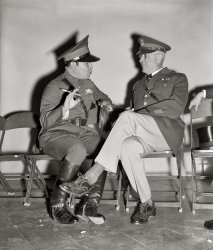
- Generation Gap: 1955
- ... into New York Harbor from Le Havre France. Theodore Roosevelt was the President of the US. On board were Giovanna and her sons Guido and Albino. ... Posted by tterrace - 09/20/2011 - 11:00pm -
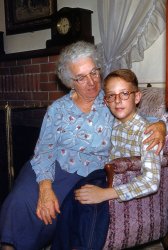
- Dry Run: 1936
- August 1936. "President Roosevelt greeted on tour of drought area. Near Bismarck, North Dakota." ... a local dignitary. A bit less pretentious than the current President's half million dollar "Beast."
Due Respect These may or may ... Posted by Dave - 07/29/2012 - 5:24pm -
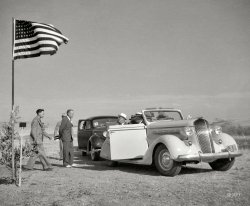
- Fairly Fun: 1942
- ...
The Asian driver This photo is dated one month after President Roosevelt's notorious Executive Order 9066, which resulted in the internment of ... Posted by Dave - 06/15/2022 - 4:36pm -
![Fairly Fun: 1942 March 1942. "Boys. Imperial County Fair, El Centro, California." Medium format acetate negative by Russell Lee for the Office of War Information. View full size.
What could go wrong?Just as so many YouTube videos show now, guys and gals in this age group run around, absolutely convinced that nothing bad can happen to them; and never thinking five seconds into the future.
Not seriousWhile not saying that this lot would never try such a stunt, the photo is pretty clearly staged: There is no motion blur (especially in the wheel spokes), no dust being kicked up, and isn't the starter crank normally removed once the engine is running?
[Look closely and you will see the trailing halves of the wheels are indeed blurred. - Dave]
It's all fun and games for the moment ...I can't help but think about the fate of these young men, especially the driver, after seeing the date of this photo and wondering their fate. Pearl Harbor had just been attacked in Dec 1941, and on Feb 19, 1942 FDR signed Executive Order 9066 authorizing the Secretary of War to establish Military Areas in which persons of Japanese heritage began being evacuated to on April 11, 1942.
InternmentI wonder what happened to the young man driving? He looks as if he could be of Japanese descent, and to our shame, many families were placed in Internment camps across America from 1942 to 1945. That day, however, he was happy with his buds. Perfect moment in time captured for all time.
The Asian driverThis photo is dated one month after President Roosevelt's notorious Executive Order 9066, which resulted in the internment of 120,000 people of Japanese ancestry, mostly from California.
Not well known today is Life Magazine's December 22, 1941 article, "How to Tell Japs from the Chinese," which had the subtitle "Angry Citizens Victimize Allies with Emotional Outburst at Enemy."
I don't know what this young man's ancestry was, but I expect that, despite this joyride, he was having some tense times in March 1942.
Old GloryDid anyone notice the American flag decal proudly displayed on the Model T's windshield? I think these Imperial Valley teens were likely not shy about their patriotism, at an especially high-level during WW2.
Half-blurredHow would the front halves be still while the backs blur?
>> the trailing halves of the wheels are indeed blurred
[This has been the subject of considerable discussion here and elsewhere. It has to do with the direction the camera shutter is traveling (top-to-bottom, left-to-right, etc.) relative to the motion of what you're photographing. An effect especially pronounced in photos of cars and carriages made with the slower exposures and focal-plane shutters the glass-plate era, where we see only half of each wheel. - Dave]
The crankHaving recently owned a model T Ford, I can tell you that the crank stays in place when not in use. Note the coil spring on it. The crank must be pressed in to engage the crankshaft, then with the spark fully retarded, quickly cranked over. If done wrong, it can kick back possibly causing a broken arm. When done correctly, it usually fires right up and the spring retracts the crank out of the way. It actually works very well.
Re: Half-blurredBut, a focal plane shutter in a 1942 medium format camera? I would expect an iris shutter. And I really don't see an motion blur.
[Look harder. The Speed Graphics that made these photos used a focal-plane shutter. - Dave]
Aftermarket body?I see a door outline on the drivers side, but it doesn't seem to have a handle or hinges. Did Ford make them that way?
[Yes. - Dave]
(The Gallery, Cars, Trucks, Buses, Russell Lee)](https://www.shorpy.com/files/images/SHORPY-8c24282a.thumbnail.jpg)
- Say Cheese: 1915
- ... drew this cartoon in 1902 after hearing that Teddy Roosevelt refused to shoot a captive bear cub that had been tied to a tree. ... was instrumental in bringing this charming memorial to a President about.
Attention, Photoshoppers... A Farkable photo if I ever ... Posted by Dave - 08/05/2012 - 1:11pm -
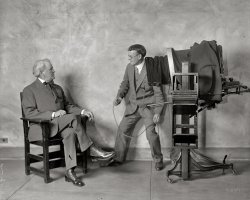
- Murdered In Pastel: 1936
- ... caricature in the cowboy hat is the then-current U.S. Vice President and prominent Texan, John Nance Garner.
I spy with my little eye ... Bernard Shaw.
Middle row: John L. Lewis, Eleanor Roosevelt, Rudy Vallee, Joan Crawford.
Third row: George Arliss (?), ... Posted by D_Chadwick - 11/19/2014 - 9:23pm -
![Murdered In Pastel: 1936 This was taken in Provincetown, Massachusetts. All I know about it is the year and location. Scanned from the original 4x5 inch acetate negative. View full size.
Air Conditioned?1936 seems a little early for a dune shack to have electrical air-conditioning. Flow-through ventilation looks to be more likely.
"In 1945, Robert Sherman of Lynn, Massachusetts invented a portable, in-window air conditioner that cooled, heated, humidified, dehumidified, and filtered the air. The idea was subsequently stolen by a large manufacturer. Sherman did not have the resources to fight the big corporation in court and thus never received any money or recognition. He died in 1962."
[The AIR CONDITIONED sign is an early humor app known as a "joke." - Dave]
Ten Gallon VeepThe caricature in the cowboy hat is the then-current U.S. Vice President and prominent Texan, John Nance Garner.
I spy with my little eyeGarbo, Jean Hersholt, Cab Calloway, Lionel Barrymore, Rudy Vallee, Katharine Hepburn, Jimmy Durante, Tallulah Bankhead, Ed Wynn, and at the top are Joseph, Benito and Adolph. The others I can't recognize.
Name that caricatureHere are my guesses:
Top row, left to right: Josef Stalin, Benito Mussolini, Adolf Hitler. Left door: top row, ? and Mark Twain; second row, Little Richard(?) and Rudy Vallee; third row, ? and Katherine Hepburn; bottom, Jimmy Durante. Right door, from top: George Bernard Shaw(?), Joan Crawford, Ed Wynn(?)
[A teensy bit early for Little Richard. -tterrace]
Famous facesTop row: Garbo, W. C. Fields (?), Eugene O'Neill, George Bernard Shaw.
Middle row: John L. Lewis, Eleanor Roosevelt, Rudy Vallee, Joan Crawford.
Third row: George Arliss (?), Katherine Hepburn, FDR.
And of course the great Schnozzola!
And the last one...Just above and right of the door looks like Snuffy Smith's wife, Loweezy, from the Barney Google and Snuffy Smith comic strip. Copyright laws then must not have been as protective of such characters as they are now.
Art ColonyThis was the artzy, bohemian and rustic Provincetown. A Provincetown where you could escape the city for the summer or live all winter on a dime. Many writers and artists sought refuge in this accepting fishing village at the end of Cape Cod.
In recent decades the wealthy have invaded. They like living in art colonies but have little tolerance for edgy characters that are a staple in any art colony. They have been driven away making the town safe for big spenders.
Today it is a real estate investment. Houses cut into a half dozen condos at 400k each, big city rents, parking meters that take credit cards and very high taxes.
Those fading character sketches can still be found on display in the Mayflower restaurant on Commercial street.
What the?!?What, possibly, in 1936, could the artist mean by the threesome labeled Faith, Hope, and Charity? Was the artist a socialist?
[I believe it's called "satire." -tterrace]
Famous facesMaybe Charles Evans Hughes instead of G. B. Shaw?
WonderWho 'D_Chadwick' was.
[It is this person. -tterrace]
Glad I have the time to repent at leisure
The DukeI think this is supposed to be Duke Ellington, the monocle a visual pun on his aristocratic nickname.
re: WonderI'm D_Chadwick and I'm not a "was" yet I'm still an "is".
As a matter of fact I'm getting better. I think I'll go for a walk.
Why the termMurdered? What did that mean in slang terms then? Now the kids all "Murder Out their Ride". *Paint the vehicle matte black everywhere including rims and trim. But then, in Pastel?
[Ruin, butcher, mangle. For example; "The tone-deaf singer murdered the song." Another joke by the caricaturist. -tterrace]
The artist Possibly Richard Miller?
[According to his sign, his name is Wheeler. -tterrace]
More of the artist's portraitsThis auction house appears to have sold some of the artist's portraits. Note the tall R in his signature.
(ShorpyBlog, Member Gallery)](https://www.shorpy.com/files/images/Murdered-In-Pastel-D_Chadwick.thumbnail.jpg)
- Bonus Army: 1932
- ... half a century ago came the New Deal of Franklin D. Roosevelt, which constructed the basic ribs of the economic safety net now so ... after the world war." Inside the mansion sat a beseiged President Hoover.
Police chief Pelham D. Glassford, World War I's youngest ... Posted by Dave - 07/31/2011 - 7:49pm -
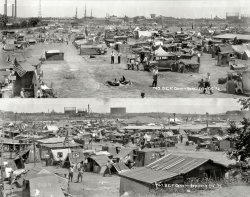
- Corridor of Power: 1939
- ... Capitol by proposed installation of a 'moving sidewalk.' President Roosevelt made the supplemental request for $200,000 in an appropriation bill ... Posted by Dave - 08/26/2012 - 11:44am -
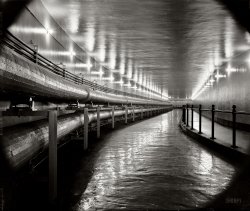
- Shirley Temple: 1928-2014
- ...
June 24, 1938. "Shirley sees her old friend the president. Shirley Temple leaving the White House today after a very important conference with the President. Shirley told Mr. Roosevelt about losing a tooth last night, and he told her about Sistie and ... Posted by Dave - 02/11/2014 - 9:30am -
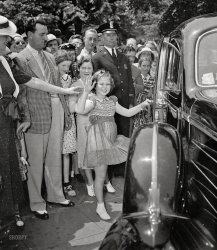
- World Series: 1933
- ... win of the Series, Washington shut out New York 4-0, with President Roosevelt in the stands. Nitrate negative by Theodor Horydczak. View full ... Posted by Dave - 07/05/2013 - 4:35pm -
![World Series: 1933 Washington, D.C. "World Series of 1933, Nationals-Giants. View of diamond, first game at Griffith Stadium." Which would be Game 3 on October 5. In the team's only win of the Series, Washington shut out New York 4-0, with President Roosevelt in the stands. Nitrate negative by Theodor Horydczak. View full size.
Ground RulesNote the open seating behind home plate; wonder what the rules would be concerning a passed ball or wild pitch that wound up back there?
I assume there was a hipster convention at the gameHow else to explain the sea of fedoras?
Presumably, the concession stands were selling PBR.
Field of hats.And only the players wear baseball caps.
He didn't get a hit.The Giants are at-bat (you can tell because the first baseman is #2, Joe Kuhel for the Senators), and though I can't make out the uniform number, none of the Giants' left-handed batters had a hit that day. (Jo-Jo Moore, Bill Terry, and Mel Ott).
It might be Mel Ott about to draw a walk from pitcher Eddie Whitehill though.
At least one Hall of Famer is pictured on the field though in shortstop Joe Cronin. And 66% chance a Hall of Famer is at bat (Bill Terry or Mel Ott).
Any other clues?
A Milliner's DreamWhen men still had class, even at the ballgame. On a side note I think in those days Washington's team was known as the Senators.
[They were officially the Nationals 1905-1956; in common parlance they were Senators to some, but more often, and in newspaper reportage, the Nationals or Nats. -tterrace]
Early in the GameJudging by the shadows and the pristine condition of the field I'm going to say this is early in the game. The Nationals had all kinds of activity in the bottom of the first inning which would have messed up the infield. So my guess is Bill Terry is getting ready to ground out 4-3 to end the first inning.
Game of the century?My nine-year-old dad was at the game that day. Perhaps somewhere in the picture?
I know later in his youth, he worked the scoreboard there, along with his schoolmate Bowie Kuhn.
Third Deck!?Griffith Stadium had only two decks. There was just an announcer's booth up there behind home plate where the stadium announcer sat (that was Charlie Brotman in the mid-50s until the stadium was replaced).
So it looks like there were some temporary stands built up there for the series. Too far away to tell if these were fans or sportswriters who couldn't fit in the existing press box at the rear of the second deck stands behind home plate.
My dad covered the Nats for the Washington Post in the late 40's - early 50's and later worked for the team. My earliest baseball memories - I was about 4 or 5 - are taking the streetcar to the stadium with him, playing with the sports tickers in his office, then watching the game from that second deck press box or sitting with Charlie in his aerie. My favorite player from that era was Roy Sievers.
I can smell the cigar smokeAnd I'm 10 years old again, in the bleachers at Briggs Stadium.
How many fans did they lose a season?No backstop behind home plate? I do see some sort of screen but it looks to be behind the gentleman in the first four rows.
The First Basemanis playing far too deep to make an out at first! And, I love the rounded grass cut-outs at first and third.
In praise of vintage ballparksWhat a difference from, say, the new Nationals Park in DC! First off, there's absolutely no advertising visible here. I don't have to describe what modern ballparks look like, but they make clear that every every square foot of vertical surface not occupied by a paying customer is up for sale. I fully expect future ballgames to sell ad space on the field, dubbed in with CGI.
Although these spectators' view was obscured by support pillars of the upper deck, that's a small price to pay for proximity. I attended a game in Tiger Stadium, where the upper deck hung over all but the first 6-10 rows of seats downstairs. With the unaided eye, sitting in the upper deck behind home, I could count the batter's shoelaces. These spectators didn't enjoy instant replays on the big screen, but they had an excellent opportunity to see the play as it happened.
Tiger Stadium was cramped, crudely constructed and the only "decorative" element was a flagpole oddly placed in center field, in play. It was a lousy place to buy food or souvenirs, but a helluva a place to watch a ballgame. Looks like this was similar.
(The Gallery, D.C., Sports, Theodor Horydczak)](https://www.shorpy.com/files/images/SHORPY_5a47422u.thumbnail.jpg)























